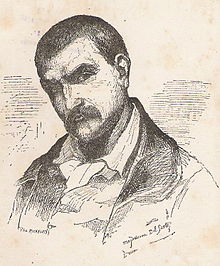François Delsarte


François Alexandre Nicolas Chéri Delsarte (19 November 1811 – 20 July 1871) was a French musician and teacher. Though he achieved some success as a composer, he is chiefly known as a teacher in singing and declamation. He went on to develop an acting style that attempted to connect the inner emotional experience of the actor with a systematized set of gestures and movements based upon his own observations of human interaction. This “Delsarte method” became so popular that it was taught throughout the world, particularly in America, by many teachers who did not fully understand or communicate the emotional connections behind the gestures, and as a result the method devolved into melodramatic posing, the kind in response to which Konstantin Stanislavski would later develop his inner psychological methods.
Applied aesthetics
Delsarte was born in Solesmes, Nord. He became a pupil at the Paris Conservatory, was for a time a tenor in the Opéra Comique, and composed a few songs. While studying singing at the Conservatoire, he became unsatisfied with the arbitrary and posed style of acting taught there. He began to study how humans actually moved, behaved and responded to various emotional and real-life situations. By observing people in real life and in public places of all kinds, he discovered certain patterns of expression, eventually called the Science of Applied Aesthetics. This consisted of a thorough examination of voice, breath, movement dynamics, encompassing all of the expressive elements of the human body.
Gymnastics
At the close of the 19th century much was said and written in America regarding Delsarte gymnastics. But François Delsarte was a teacher of emotional expression through voice and gesture, not the inventor of a system or method of gymnastics. "Relaxing" exercises and training in poise and in breathing control form a part of the necessary preparation for effective appearance on the platform or the stage; but complete physical education of the growing child and youth could never be accomplished by such means, and the adult requires a much broader range of motor activities. Therefore, Delsarte gymnastics was an improper American application of the theories of François Delsarte.[citation needed]
Influence and impact
Delsarte's work inspired modern dancers such as Isadora Duncan, Ruth St. Denis and Ted Shawn. Rudolf Laban and F. Matthias Alexander also studied Delsarte's teachings until they later developed their own methods. Alexander was certainly aware of Delsarte's work; his performing arts school in Sydney and his teaching paraphernalia both mention the Delsarte System along with Alexander's own method.
Delsarte never wrote a book explaining his method, and neither did his only protégé, actor Steele MacKaye. However, MacKaye's student Genevieve Stebbins did write a book in 1885 titled The Delsarte System of Expression, which became a wild success. In 1892 Edward B. Warman wrote a similar guide to Delsarte's teachings, Gestures and Attitudes.[1]
Ironically, it was the great success of the Delsarte System that was also its undoing. By the 1890s, it was being taught everywhere, and not always in accordance with the emotional basis that Delsarte originally had in mind. No certification was needed to teach a course with the name Delsarte attached, and the study regressed into empty posing with little emotional truth behind it. Wangh concludes, "it led others into stereotyped and melodramatic gesticulation, devoid of the very heart that Delsarte had sought to restore." Despite this, modern Anglophone yoga classes closely resemble the Delsarte "gymnastics" as taught by Genevieve Stubbins. Arguably, the fad may be an uncredited forerunner of postural yoga as taught today, as Mark Singleton speculates in Yoga Body: The Origins of Modern Posture Practice.
Family
Delsarte was the uncle of composer Georges Bizet and grandfather of painter Thérèse Geraldy.
Further reading
- Franck Waille, Christophe Damour (dir.), François Delsarte, une recherche sans fin, Paris, L'Harmattan, 2015.
- This article incorporates text from a publication now in the public domain: Gilman, D. C.; Peck, H. T.; Colby, F. M., eds. (1905). New International Encyclopedia (1st ed.). New York: Dodd, Mead.
{{cite encyclopedia}}: Missing or empty|title=(help) - Ted Shawn, Every Little Movement: A Book about François Delsarte, the Man and his Philosophy, his Science and Applied Aesthetics, the Application of this Science to the Art of the Dance, the Influence of Delsarte on American Dance, 1963
- Wangh, Stephen. An Acrobat of the Heart: A Physical Approach to Acting Inspired by the Work of Jerzy Grotowski. New York: Vintage Books, 2000.
- Franck Waille (dir.), Trois décennies de recherches européennes sur François Delsarte, Paris, L'Harmattan, 2011.
- Alain Porte, François Delsarte, une anthologie, Paris, IPMC, 1992.
- Williams, Joe, A Brief History of Delsarte
- Franck Waille, Corps, arts et spiritualité chez François Delsarte (1811–1871). Des interactions dynamiques, PhD in history, Lyon, Université Lyon 3, 2009, 1032 pages + CDROM of annexes (manuscripts, interview of Joe Williams, video reconstitutions of body exercises) (the last and longer chapter of this thesis concerns Delsarte training for the body).
- Nancy Lee Chalfa Ruyter, "The Delsarte Heritage," Dance Research: The Journal of the Society for Dance Research, 14, no. 1 (Summer, 1996), pp. 62–74.
- Delsarte system of expression, by Genevieve Stebbins; public-domain, online version on Internet Archive.
- Singleton, Mark, "Yoga Body: The Origins of Modern Posture Practice", Oxford University Press, February 10, 2010.
- Eleanor Georgen, The Delsarte system of physical culture (1893) (Internet Archive)
- Warman, Edward B. Gestures and Attitudes: Exposition of the Delsarte Philosophy of Expression, Practical and Theoretical, 1892
